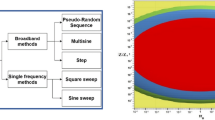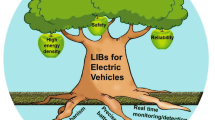Abstract
A reliable diagnostics of lead-acid batteries would become mandatory with the induction of an improved power net and the increase of electrically assisted features in future automobiles. Sparse-impedance spectroscopic technique described in this paper estimates the internal resistance of sealed automotive lead-acid batteries in the frequency range 10 Hz-10 kHz, usually produced by the alternators fitted in the automobiles. The state-of-health of the battery could be monitored from its internal resistance.
Similar content being viewed by others
References
Dell R M and Rand D A J 2002Understanding batteries (Cambridge: Royal Society of Chemistry)
Fuet F 1998J. Power Sources 70 59
Piller S, Perrin M and Jossen A 2001J. Power Sources 96 113
Rodrigues S, Munichandraiah N and Shukla A K 2000J. Power Sources 87 12
Shukla A K, Ganesh Kumar V, Munichandraiah N and Srinath T 1998J. Power Sources 74 234
Champlin K and Bertness K 2000Proc. 22nd Int. Telecommun. Energy Conf. (Phoenix:IEEE) paper 19.3 348
Charlesworth J M 1996Electrochim. Acta 41 1721
Nelatury S R and Singh P 2002J. Power Sources 112 621
Salkind A J, Fennie C, Singh P, Atwater T and Reisner D E 1999J. Power Sources 80 293
Stoynov Z, Nishev T, Vacheva V and Stamenova N 1997J. Power Sources 64 189
Martinet S, Durand R, Ozil P, Lablanc P and Blanchard P 1999J. Power Sources 83 93
Feder D O, Hlavac M J and McShane S J 1994J. Power Sources 48 135
Armenta C, Doria J, De Andrès M C, Urratia J, Fullea J and Graña F 1989J. Power Sources 27 189
Baert D H J and Vervaet A A K 2003J. Power Sources 114 357
Blood P J and Sotiropoulos S 2002J. Power Sources 110 96
Mancier V, Metrot A and Willmann P 2003J. Power Sources 117 223
Mancier V, Metrot A and Willmann P 2002Electrochim. Acta 47 1633
Hill I R and Andrukaitis Ed E 2001J. Power Sources 103 98
Mauracher P and Karden E 1997J. Power Sources 67 69
Jossen A, Späth V, Döring H and Garche J 1999J. Power Sources 84 283
Stoynov Z, Savova-Stoynov B and Kossev T 1990J. Power Sources 30 275
Salkind A, Atwater T, Singh P, Nelatury S, Damodar S, Fennie Jr C and Reisner D 2001J. Power Sources 96 151
Tenno A, Tenno R and Suntio T 2001J. Power Sources 103 42
Meissner E and Richter G 2003J. Power Sources 116 79
Karden E, Buller S, Rik W and De Doncker 2002Electrochim. Acta 47 2347
Buller S, Walter J, Karden E and De Doncker R W 2002Adv. Automotive Battery Conf., Las Vegas
Goodenough J B and Shukla A K 1988Solid state ionic devices (eds)B V R Chowdhari and S Radhakrishna (Singapore: World Scientific) p. 573
Venugopalan S 1992 Ph D thesis, Indian Institute of Science, Bangalore
Linden D and Reddy T B (eds) 2002Handbook of batteries 3rd edn (New York: McGraw-Hill)
Author information
Authors and Affiliations
Corresponding author
Additional information
Dedicated to Professor C N R Rao on his 70th birthday
Rights and permissions
About this article
Cite this article
Hariprakash, B., Martha, S.K. & Shukla, A.K. Monitoring sealed automotive lead-acid batteries by sparse-impedance spectroscopy. J Chem Sci 115, 465–472 (2003). https://doi.org/10.1007/BF02708238
Issue Date:
DOI: https://doi.org/10.1007/BF02708238




